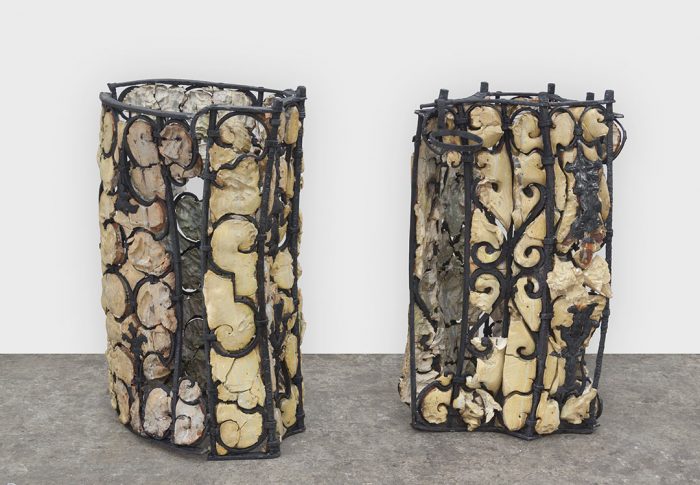Tiempo de lectura: 4 minutos

13.08.2019
Museum of the African Diaspora, San Francisco, California, USA
8 de mayo de 2019 – 11 de agosto de 2019



“Those alive to ever-present signifiers of enslavement and colonialism have to look no further than the average bottle of rum. For the labels either contain supposedly comforting artistic renderings of benevolent plantation scenes, or these labels boldly and proudly declare that the product has a centuries-old manufacturing pedigree. We don’t have to do much speculating as to what sorts of people were obliged to do pretty much all of the work.”
—Eddie Chambers, from his catalog essay Coffee, Rhum, Sugar & Gold: A Postcolonial Paradox. Some Considerations
Coffee, Rhum, Sugar & Gold: A Postcolonial Paradox, an original exhibition on view at MoAD, looks at the legacy of European colonialism in the Caribbean through the work of ten contemporary artists. Whether connected to the Caribbean by birth or focused on the region by choice, the exhibiting artists use their work as a means of examining the relationship between the power structure, those who are controlled by it, those who benefit from it, and those who actively seek to liberate themselves from it.
With roots in a variety of Caribbean countries including the Bahamas, Dominican Republic, Haiti, Jamaica, and Puerto Rico, participating artists are Firelei Báez, Leonardo Benzant, Andrea Chung, Adler Guerrier, Lucia Hierro, Lavar Munroe, Angel Otero, Ebony G. Patterson, Phillip Thomas, and Didier William.
Coffee, Rhum, Sugar & Gold: A Postcolonial Paradox is curated by first-time MoAD contributing curator Larry Ossei-Mensah, Susanne Feld Hilberry Senior Curator at the Museum of Contemporary Art Detroit and Co-Founder of ARTNOIR, and Dexter Wimberly, independent curator and Founder & CEO of Art World Conference, whose prior curatorial work for MoAD includes the 2017 traveling exhibition The Ease of Fiction.
The exhibition title is inspired by some of the core products that have historically been produced in and exported from the Caribbean to the rest of the world. A key driver of the exhibition is the theory that colonialism has continued to exist in other forms, and is in fact spreading through the export of soft power, the use of military force, the control of international financial and banking mechanisms, as well as the increase in globalization.
“Colonialism is often discussed in the past tense,” states Wimberly. “We want to look at how it impacts modern day life. More specifically, Coffee, Rhum, Sugar, & Gold: A Postcolonial Paradox is concerned with how colonialism’s legacy can be seen throughout the politics and economies of the Caribbean and beyond.”
“Themes such as imperialism, hegemony, and neo-colonialism are not just relics of the past, but are notions the influence today’s policies which are very visible in our present day,” says Ossei-Mensah. “They may be called different names like nationalism, BREXIT, or foreign aid, but they all are mechanisms designed to control and oppress the ‘other.’ We hope people leave the exhibition feeling inspired, empowered, and informed—ready to challenge the status quo.”
Coffee, Rhum, Sugar & Gold: A Postcolonial Paradox features more than twenty-five works in a variety of media including mixed media installation, painting, and sculpture.
Phillip Thomas’ large-scale triptych on canvas, Pimper’s Paradise, the Terra Nova nights edition (2018) shows how fashion can function as a tool or weapon of differentiation, subordination, and re-colonization. Dispersed throughout the background of the piece are images of plantation society, racial subordination, and wealth, while in the foreground are the contemporary signatures of upwardly mobile wealth. In Thomas’ work, fashion operates as a signifier of class, economic mobility, subordination, and social alienation.
Firelei Báez contributes three works to the exhibition including her painting, How to Slip Out of Your Body Quietly (2018), in which human legs protrude from under sprouted palm seeds, a work born out of the artist’s interest in the way culture and identity are shaped by inherited histories.
Leonardo Benzant’s mixed-media work emerges from his ongoing and deep exploration of his Afro-Dominican heritage. His totem-like sculpture, The Tongue On The Blade: Serenade for Aponte And All Those Who Have Vision (2017) is inspired by historical figure José Antonio Aponte’s lost book of paintings, discovered in Havana in 1812 as authorities investigated a rebellion and conspiracy to end slavery in Cuba.
Resembling an outsized, semi-translucent bag overflowing with blown-up replicas of Embajador (Ambassador) Chocolate, Lucia Hierro’s Embajador (2017) borrows from pop culture, the history of art, and everyday items of the working class in the US and the Caribbean. The monumentality of her work, and elevation of the status of objects, engages the viewer in a discourse on issues of class, culture, identity, and gender.
Five of Lavar Munroe’s sculptures from his Gun Dogs series will be on display. Made from cardboard, deconstructed Junkanoo (Bahamian Carnival) costumes, and found toys and objects, Munroe says of these works, “Throughout history, dogs have been used for various reasons ranging from farm work, to slave hunting, to law enforcement and personal protection. The black mind and body have endured extreme trauma in relation to these animals. Gun Dogs also served as the name of a prominent street gang in the Bain and Grants Town area (Nassau, Bahamas) in the late 80s, early 90s. [The dog] identified the menaces and outcasts from society who thrived on the notion of ‘survival by all means.”
—
Comentarios
No hay comentarios disponibles.